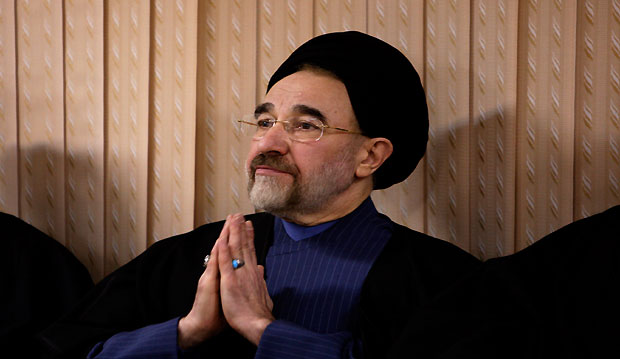Former Iranian president Mohammad Khatami did not attend Rouhani’s inauguration ceremony. I examined the faces of everyone in attendance while watching the event, which was held in the office of the supreme leader. Khatami’s absence raised a lot of questions. Why was he not invited? If he had been invited, why did he not attend?
The supreme leader of Iran, Ayatollah Ali Khamenei, officially endorsed Rouhani’s appointment to the country’s presidency for the next four years. The ceremony was attended by senior Iranian officials and political figures, including the chairman of the Expediency Discernment Council, Ali Akbar Hashemi Rafsanjani, the parliamentary speaker, Ali Larijani, the head of the judiciary, Sadeq Larijani, the head of the Guardian Council and former president, Mahmoud Ahmadinejad.
Former presidential candidates also attended, such as Mohammad Reza Arif, Mohammad-Bagher Ghalibaf, Mohsen Rezaee, Gholam Ali Haddad Adel, Sa’id Jalili, Ali Akbar Velayati, and Mohammad Gharazi.
But Khatami’s absence was obvious.
Shaheen Mohammad Sadeghi, a member of parliament, revealed Monday that Khatami had not been invited to the ceremony.
Rouhani succeeded Mahmoud Ahmadinejad, who ended his second term on Saturday, August 3. His presidential inauguration ceremony took place in parliament the following day in the presence of 55 foreign delegates. These included 11 presidents and prime ministers, eight vice presidents, and seven heads of parliaments. It was the first time that Iran had invited foreign leaders to attend a presidential inauguration. Everyone who watched the ceremony would have noticed two men who were conspicuous by their absence. The ceremony was attended by the presidents of Togo and Guinea-Bissau, but the former Iranian presidents Mahmoud Ahmadinejad and Mohammad Khatami were not to be seen.
How can we analyse this strange absence? What are the reasons for it? Is it another example of Iranian confusion?
Dore Gold, former Israeli ambassador to the United Kingdom, wrote a book about Iran as a regional power. In it, he quoted Sir Denis Wright, the British ambassador to Iran in the 1970’s, as saying: “The Iranians say the opposite of what people think, and do the opposite of what they say.” There is a clear exaggeration here, but I do believe that the political scene in Iran is very complex.
This strange event has two aspects—Ahmadinejad’s absence and that of Khatami. But, essentially, Ahmadinejad’s absence is not important, since his era has come to an end, and his victory in the previous presidential elections raised serious doubts. Khatami, on the other hand, is one of the best-known figures in Iran, and has a large influence on the political and social scenes in Iran. The recent presidential elections, which took place in June, highlighted the impact of Khatami and Hashemi Rafsanjani, who were the architects of the presidential election. In addition, Khatami is currently considered the leader of the reformist movement. For example, when Aref withdrew from the presidential elections, he announced that his decision was based on a letter from Khatami, leader of the reformist front in Iran.
In addition to this, Khatami was the president of Iran for two terms. So why did he not participate in the ceremonies of Rouhani’s endorsement or swearing-in?
I believe that there are two very important votes in Iran. In every presidential election there are two votes that carry clear messages, but there are often deep contradictions between them. The first is the national ballot box, available to all Iranians inside and outside of the country. The second is a phone number, 110, which is used by the supreme leader, his close disciples and those who work with them in the office of the supreme leader.
The results of both ballots should be studied carefully. Jalili, Iran’s chief negotiator and secretary of the Supreme Council for National Security, obtained 80 percent of the roughly 200 votes from ballot box number 110. Rouhani received only 17 votes. On the other hand, the results of the national ballot box were completely different, with Rouhani receiving more than 18 million votes, and Jalili less than four million. In addition, the former head of the Guardian Council said in his last interview that Jalili received the largest share of votes within the council. Remember also that the Guardian Council did not agree on the nomination of Hashemi Rafsanjani.
Fortunately, there is a good sign that we can be convinced of the inner circles of the government and leadership support Rouhani. That sign is Khamenei’s approval the cabinet nominations that Rouhani presented to parliament during the swearing-in ceremony on August 4. The cabinet consists of reformist figures, which prompted the Kayhan newspaper—a mouthpiece for the religious and extremist factions in Iran—to suggest that some ministers be removed from the list, including the oil minister, Bezn Zangana, and the minister of labor and social welfare, Ali Rabiee. Likewise, Haddad-Adel expressed that he wanted to make the cabinet more acceptable.
Haddad-Adel and Kayhan are known to belong to ballot box 110, and they have indicated that they want to have some of the ministers removed. This shows that the two sides face a serious confrontation.
I recently read a book by Daron Acemoglu and James Robinson called Why Nations Fail: The Origins of Power, Prosperity and Poverty. He says in short that every time powers try to use ballot box 110 and impose their will against that of the nation, it marks the beginning of the end.
